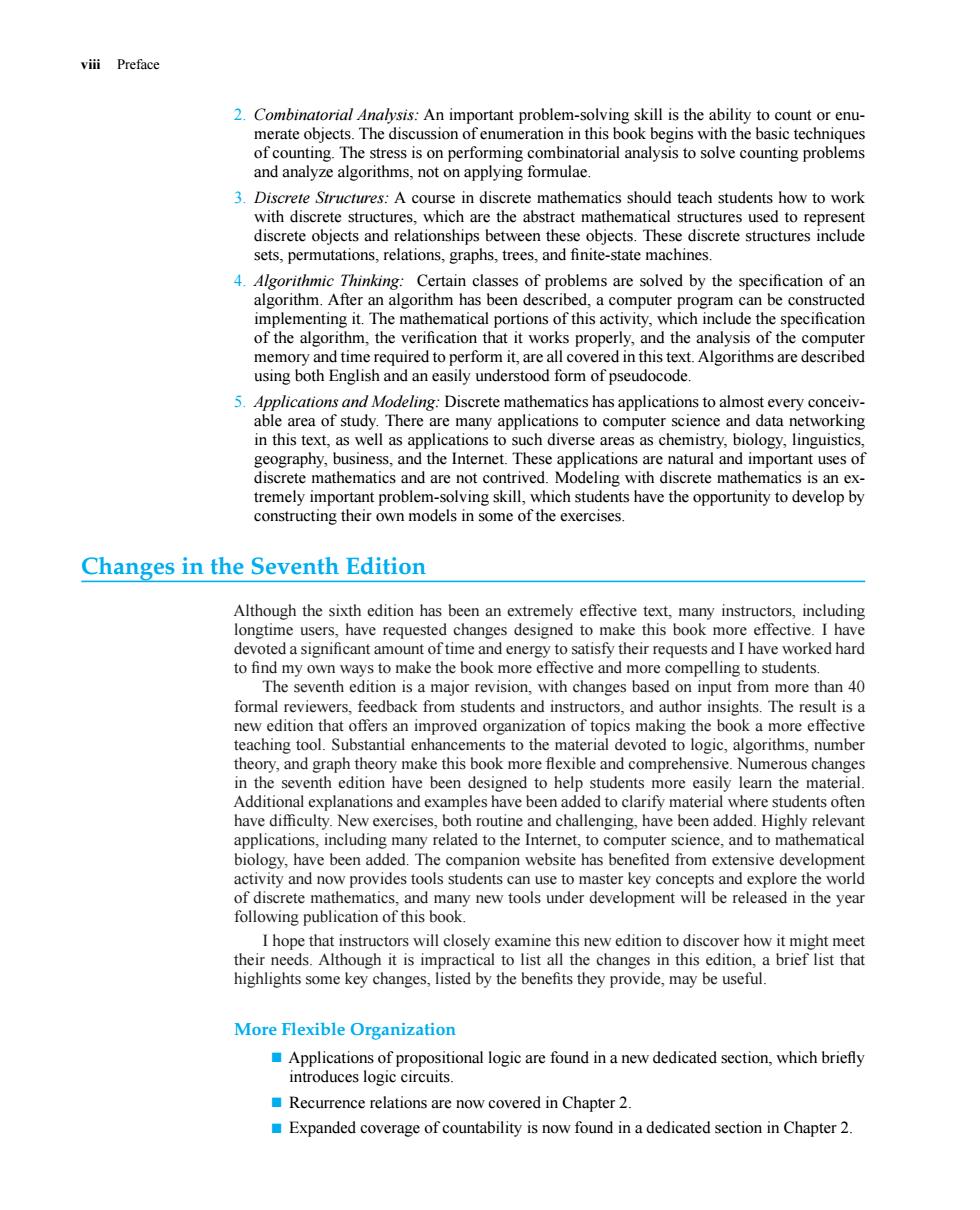正在加载图片...

vii Preface 2.Combinatorial Analysis:An important problem-solving skill is the ability to count or enu- merate objects.The discussion of enumeration in this book begins with the basic techniques 3.Discrete Structures:A course in discrete mathematics should teach students how to work with discrete structures,which are the abstract mathematical structures used to represent discrete objects and relationships between these objects.These discrete structures include sets,permutations,relations,graphs,trees,and finite-state machines 4 Algorithmic Thinking:Certain classes of problems are solved by the specification of an algorithm.After an algorithm has been described,a computer program can be constructed implementing it.The mathematical portions of this activity,which include the specification of the algorithm,the verification that it works properly,and the analysis of the computer 5.Applications and Modeling:Discrete mathematics has applications to almost every conceiv able area of study. Ihere are many applications to computer science and data networking in this t as well as apple a ns to s h diverse areas as chemistry, geography, tremely important problem-solving skill.which students have the opportunity to develop by constructing their own models in some of the exercises. Changes in the Seventh Edition Although the sixth edition has been an extremely effective text many instructors including longtime users.have requested changes designed to make this book more effective.I have devoted a significant amount of time and energy to satisfy their requests and I have worked hard ys to make the book mor ecve and more compend s a major revision,with changes ba om more than 40 0 1S 2 ed to lo theory,and graph theory make this book more flexible and comprehensive.Numerous changes in the seventh edition have been designed to help students more easily learn the material Additional explanations and examples have been added to clarify material where students often have dimculty w exercises. th routine and challenging,have been added. Highly relevan ed to the Int ence,and to thematic nde be as ben from ex nsive deve of discrete mathematics.and many new tools under development will be released in the year following publication of this book. I hone that instructors will closely w edition to diseover how it might r their needs Alth ugh it is impractical to list all the changes in this edition.a brief list that highlights some key changes,listed by the benefits they provide,may be useful. More Flexible Organization A2PlitecgTogcPPeCmeionalogcaefoundnanevdcdicaedsciomwhohbicd Recurrence relations are now covered in Chapter 2. Expanded coverage of countability is now found in a dedicated section in Chapter2. viii Preface 2. Combinatorial Analysis: An important problem-solving skill is the ability to count or enumerate objects. The discussion of enumeration in this book begins with the basic techniques of counting. The stress is on performing combinatorial analysis to solve counting problems and analyze algorithms, not on applying formulae. 3. Discrete Structures: A course in discrete mathematics should teach students how to work with discrete structures, which are the abstract mathematical structures used to represent discrete objects and relationships between these objects. These discrete structures include sets, permutations, relations, graphs, trees, and finite-state machines. 4. Algorithmic Thinking: Certain classes of problems are solved by the specification of an algorithm. After an algorithm has been described, a computer program can be constructed implementing it. The mathematical portions of this activity, which include the specification of the algorithm, the verification that it works properly, and the analysis of the computer memory and time required to perform it, are all covered in this text. Algorithms are described using both English and an easily understood form of pseudocode. 5. Applications and Modeling: Discrete mathematics has applications to almost every conceivable area of study. There are many applications to computer science and data networking in this text, as well as applications to such diverse areas as chemistry, biology, linguistics, geography, business, and the Internet. These applications are natural and important uses of discrete mathematics and are not contrived. Modeling with discrete mathematics is an extremely important problem-solving skill, which students have the opportunity to develop by constructing their own models in some of the exercises. Changes in the Seventh Edition Although the sixth edition has been an extremely effective text, many instructors, including longtime users, have requested changes designed to make this book more effective. I have devoted a significant amount of time and energy to satisfy their requests and I have worked hard to find my own ways to make the book more effective and more compelling to students. The seventh edition is a major revision, with changes based on input from more than 40 formal reviewers, feedback from students and instructors, and author insights. The result is a new edition that offers an improved organization of topics making the book a more effective teaching tool. Substantial enhancements to the material devoted to logic, algorithms, number theory, and graph theory make this book more flexible and comprehensive. Numerous changes in the seventh edition have been designed to help students more easily learn the material. Additional explanations and examples have been added to clarify material where students often have difficulty. New exercises, both routine and challenging, have been added. Highly relevant applications, including many related to the Internet, to computer science, and to mathematical biology, have been added. The companion website has benefited from extensive development activity and now provides tools students can use to master key concepts and explore the world of discrete mathematics, and many new tools under development will be released in the year following publication of this book. I hope that instructors will closely examine this new edition to discover how it might meet their needs. Although it is impractical to list all the changes in this edition, a brief list that highlights some key changes, listed by the benefits they provide, may be useful. More Flexible Organization Applications of propositional logic are found in a new dedicated section, which briefly introduces logic circuits. Recurrence relations are now covered in Chapter 2. Expanded coverage of countability is now found in a dedicated section in Chapter 2.���